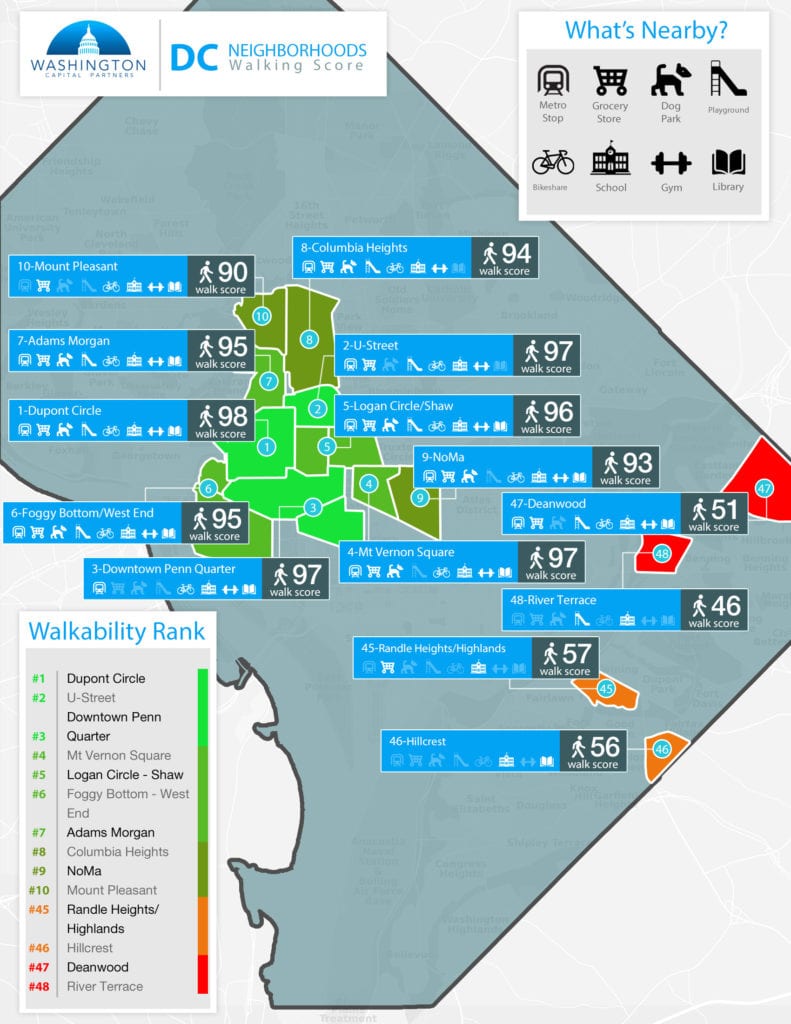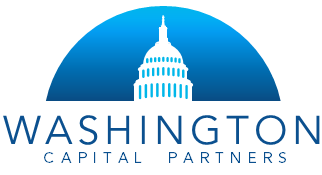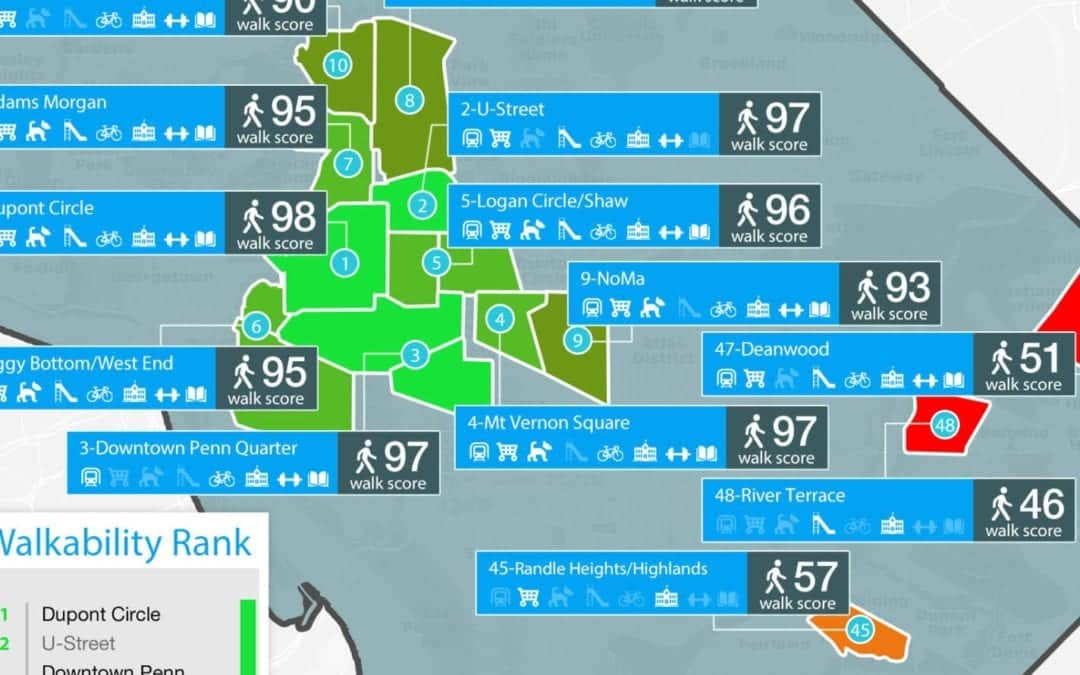Do you have clients looking for a home in the DC area? The map below shows you which DC neighborhoods have the highest and lowest walk scores and the different characteristics each have to offer. It gives your client a visual understanding of popular DC neighborhoods, while also helping you line up property tours in neighborhoods that fit your client’s preferences and lifestyle.
Real estate investors and realtors that invest should also use this map to get a feel for the neighborhood features that can increase your flip’s value. Once you’re ready for financing, pre-qualify for the loan program that suits your investment style.

Please use the HTML code below to embed this graphic:
Those looking to live car-free in DC’s most walkable neighborhoods should focus on these top 10 neighborhoods. While each neighborhood has something unique to offer, access to metro stations, activities, and overall convenience earn them their high scores.
#1 Walk Score for Dupont Circle
The neighborhood that’s open to all, has it all. With the Dupont Circle Metro station, several bus lines, protected bike lanes, and pedestrian walkways, it’s easy to live here comfortably car-free. According to Walk Score, the neighborhood’s 17,057 residents can walk to an average of 47 restaurants, bars, and coffee shops in about 5 minutes.
With a large population of young and international residents, it’s no surprise that Dupont Circle is home to a dense concentration of libraries including:
- The Polish Library (For a small membership fee, individuals interested in or of Polish-heritage can browse over 7,000 books by Polish authors or about Poland)
- German Historical Institute
- Mason Library Washington D.C. (Open to Johns Hopkins students and alumnus)
- West End Neighborhood Library
#2 Walk Score for U Street
A vibrant collection of bars, coffee shops, and ethnic cuisine make U-Street one of the city’s most popular destinations for out-of-towners and party goers. However, those looking for a place to call home in the U Street Corridor will find that the “Barfly’s Paradise” offers a lot more than nightlife. Its large collection of art galleries and eclectic shops gives DCs most creative residents a place to call home.
Locals with small children can retreat away from the bustling scene of U Street’s restaurants and bars by walking to the Westminster Playground. Tucked away between some rowhomes, the well-maintained playground with its colorful mural-painted walls have toys for all ages and even a water area in the summer.
#3 Walk Score for Downtown Penn Quarter
On any given day, you’ll likely see Caps fans, Wizards fans, or concert-goers walking the streets of the Downtown Penn Quarter all headed to the Capital One Arena. With the largest arena in the district and the neighborhood’s vibrant scene of authentic Chinese food and museums, the Downtown Penn Quarter attracts a lot of sightseers. Nevertheless, 10,000 people call this sports and entertainment destination home.
In terms of transit, Penn Quarter residents have access to the Gallery Place-Chinatown and Archives-Navy Penn Quarter metro stations as well as nearby Metro Center hub that links to 4 lines. Bikers will find multiple bike sharing stations conveniently scattered throughout the neighborhood.
#4 Walk Score for Mt Vernon Square
Mt Vernon Square is close to everything you want, while far enough to give you a residential feel. Locals have their pick from multiple grocery stores including a 24-hour Safeway and Streets Market. Health-conscious people have a lot of options for exercise with everything from hot yoga studios to cross-training facilities just a short walk away.
Commuting residents have their pick of the green or yellow lines of the Mt Vernon Sq – 7th St-Convention center metro station.
#5 Walk Score for Logan Circle
Logan Circle’s 21,218 residents have access to 296 restaurants, bars, and coffee shops, including the well-known French bistro, Le Diplomate. Residents can stay within the neighborhood’s boundaries when they need to get groceries at Whole Foods or Trader Joes. From CrossFit facilities or a cycling class, residents have plenty of options for fitness in Logan Circle.
#6 Walk Score for Foggy Bottom-West End
Home to DC’s most famous institution of higher learning – George Washington University and the highly rated Schools Without Walls High School, Foggy Bottom – West End is the 6th most walkable neighborhood in the District. According to Walk Score, 410 restaurants, bars, and coffee shops are just a 5-minute walk away.
With the Foggy Bottom – GWU metro station, 11 bus lines, and 3 subway lines residents have no problem commuting out the neighborhood without a car. The neighborhood’s excellent public transportation also makes it easy for GWU’s 25,000 students to get to and from campus.
#7 Walk Score for Adams Morgan
Historically known for its bar scene and ethnic eateries attracting professionals and singles, Adams Morgan is becoming an up-and-coming neighborhood for young families. With the nearby National Zoo and 2 highly-rated public elementary schools: H.D. Cooke Elementary and Marie Reed Elementary – more and more young families are calling Adams Morgan home.
Excellent public transportation, multiple grocery stores, and fitness studios make it easy to get daily errands accomplished on foot or bike. And anyone who lives here with a dog will love spending afternoons at the S Street dog park. It has park benches for humans and paddling pools for your furry friends when it gets hot.
#8 Walk Score for Columbia Heights
Columbia Height’s 35,322 residents have no problem getting errands done with several chain grocery stores, corner stores, and a variety of gyms nearby. For activities outside of the neighborhood, residents have the Columbia Heights metro station nearby and the Georgia Ave-Petworth metro station just north of the neighborhood in the nearby Petworth.
Children in Columbia Heights attend Benjamin Banneker High School. According to Niche, Benjamin Banneker Academic High School is the #5 out of 34 for the best high school in the District and received an overall grade of an A.
#9 Walk Score for NoMa
With plentiful bike lanes, Walk Score has coined NoMa as a “biker’s paradise.” Residents on foot can easily get to the red-lined Union Station and NoMa-Gallaudet U New York Ave metro stations. Within NoMa are 2 dog parks, a Walmart Supercenter, a Harris Teeter, and a Safeway.
#10 Walk Score for Mount Pleasant
Mount Pleasant is the 10th most walkable neighborhood in Washington D.C. It’s 10,443 residents can walk or bike to a variety of 106 restaurants, bars, and cafes.
In addition to 5 grocery stores, residents can get local meat, produce, herbs, and flowers at the Mount Pleasant Farmers’ Market held every Saturday morning.
At the bottom of the list, these DC neighborhoods are missing the convenient features that others have. Realtors and real estate investors should be wary to buy in these neighborhoods due to their lack in walkability.
#45 Walk Score for Randle Heights/Highlands
With a walking score of 45, the Randle Heights/Highlands area lacks a lot of the conveniences and variety compared to other neighborhoods in the District. This Southeast neighborhood offers 3 small options for groceries: Dollar Plus and Food, Surprise Grocery, and J&D market. For a larger grocery store, residents can travel to the nearby Naylor Gardens neighborhood where they’ll find a Safeway.
#46 Walk Score for Hillcrest
Although some parts of Hillcrest offer spectacular views of the Capitol and Washington Monument, this neighborhood has very few amenities. It’s mostly residential, comprised of single-family dwellings and a couple of apartment buildings.
According to Walk Score, it’s 3,724 residents have access to 9 restaurants, bars, and coffee shops within the neighborhood.
#47 Walk Score for Deanwood
Although it was named one of the 10 “hottest” neighborhoods for fix and flips in 2017, Deanwood is still lacking in walkability. It’s 8,813 residents are limited to about 12 restaurants, bars, and coffee shops. They shop at 2 small grocery stores: Suburban Market and A&S Grocery, however, residents often travel outside the neighborhood to nearby Benning for Safeway and Carver/Langston for Aldi. Because the neighborhood is serviced by the orange-lined Deanwood metro station, residents have no problem commuting out of the neighborhood.
Community residents and those from nearby neighborhoods can enjoy the activities of the highly-rated Deanwood Recreation Center for an annual membership fee. Some of the activities and facilities include:
- Indoor swimming pool
- Library
- Multi-purpose fields mostly for football and soccer
- Playground
#48 Walk Score for River Terrace
As DC’s least walkable city, River Terrace is almost exclusively residential. Rowhouses, duplexes, and a few apartment buildings house it’s 4,814 residents. Children within River Terrace go to Thomas Elementary School which has an overall Niche grade of a C.
Both the River Terrace Recreation Center and Anacostia Riverwalk Playground give families a place for outdoor activities and sports. Although there are no metro stations within River Terrace, residents can walk to the nearby Minnesota Avenue metro station or catch a bus on one of the 6 bus lines that pass through the neighborhood.
Get a Free Customized DC Neighborhoods Walk Score Map
Get a personalized version of the DC Neighborhoods Walk Score Map with your logo and contact information. Use your custom map to send to clients are a resource or use it on property tours. Submit your logo and contact information using the quick form and receive a free custom map.

